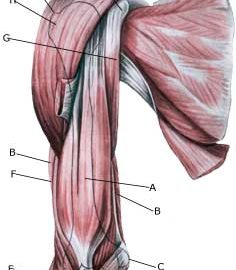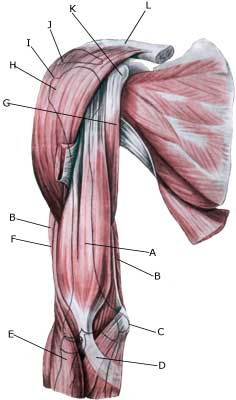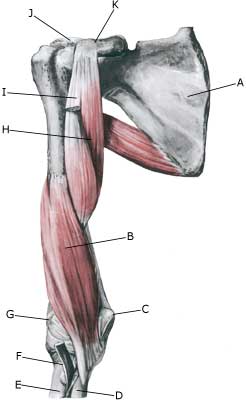|
||
|
||
|
||
| Cause: When a muscle is suddenly subjected to a load beyond the strength of the muscle, a rupture occurs. The vast majority of ruptures are partial muscle ruptures. Ruptures occur most often if the muscle is contracting at the same time as it is being stretched (eccentric contraction). Full ruptures are most frequently seen in elderly persons and generally localised to the long head of the biceps tendon at the shoulder joint (caput longum biceps brachii) or at the tendon fastening in the elbow (aponeurosis musculi bicipitis brachii).
Symptoms: In light cases a local tenderness is felt after the load (“strained muscle”, “imminent pulled muscle”). In severe cases sudden shooting pains are felt in the muscle (“partial muscle rupture”, “pulled muscle”) and in the worst case a violent snap is felt, after which bending the elbow against resistance is severely reduced (“total muscle rupture”). With muscle injuries the following three symptoms are characteristic: pain upon applying pressure, stretching (stretch the elbow) and activation against resistance (bending the elbow). With many elderly the rupture has not produced symptoms. Acute treatment: Click here. Examination: In light cases with only minimal tenderness medical examination is not necessarily required. In cases of more pronounced pain or difficulty using the arm (bending the elbow and rotate the hand (suppination)) a medical examination should be carried out to ensure the correct diagnosis and treatment. It can be necessary to supplement the normal clinical examination with an ultrasound scan (article 1) or an MRI scan (article 2). Treatment: Most partial ruptures are treated with relief and rehabilitation. Only in cases with total or near-total ruptures, especially in young people, is surgery advised (article 1) (article 2) (article 3). Complications: If progress is not smooth, you should be (re)examined and consider whether the diagnosis is correct or whether complications have arisen. Ruptures of the long biceps head can be combined with other injuries in the shoulder, for instance inflammation of the biceps muscle and complications for muscular bleeding. |



